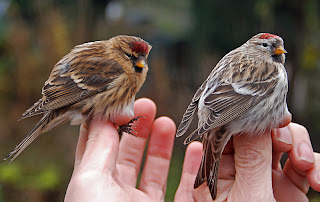Wednesday evening I headed to Bram in Nijmegen. We had planned the Thursday to do some ringing. When we woke up the next morning a look outside and a look on Buienradar.nl made us want to stay in our bed, just awful weather! There was a strong wind blowing outside and Buienradar told us a lot of raining was coming our way. It would still be dry a few hours so we decided to head out and open some nets. Throughout the morning we caught the incredible amount of 4 birds: 2 Great Tits, a Blackcap and a Nuthatch.
Nuthatch (Sitta europaea), juvenile male; lots of chestnut-brown feathers on the flanks and undertailcoverts.
indicating a male.
In the afternoon - after the many millimetres of rain - the weather became better and the sun was shining. We decided to head out again and do some work. Bram is going to ring the entire autumn (from August to November) at the Ooijse Graaf so some maintenance work was needed. Before we did some work we did some birdwatching, hearing Middle-spotted Woodpecker, Green Woodpecker and some Hawfinches.
Two weeks ago I passed my driving exam so I'm in the possession of a driving license finally: I'm a very happy ringer now! Bram's mum was so kind to let us use her car to drive to the Ooijse Graaf with all our equipment. The drive went smooth (I didn't drive over any children) and after we arrived the hard work could start.
We transported a lot of wooden planks with us so we could build some platforms for in the reeds.
I pull weird faces when I'm concentrating..
We were able to make a few platforms; we stabilized the path in the reeds very well now, no danger of drowning anymore, haha! Some cleaning of the net rides was also done. Around 1930 Bram's mum came along and we had a nice dinner in the Ooijse Graaf, seeing the sun go down.
As the weather stayed stable, we decided to open some nets in the reeds to try our luck with roosting swallows/ and or yellow wagtails. We put a tape near the nets and then we could start the waiting. Some 30 Yellow Wagtails and equal numbers of Barn Swallows dropped in to roost, togehter with a few hundred starlings - we didn't want too many of those in the net though. The catch was quite decent, as it was the first roosting session. The number of Barn Swallows that found their way into our nets was a little bit dissapointing: 1. But the we had a the 11 Yellow Wagtails hanging in the net, which was a real treat! The 11 Yellow Wagtails existed out of 9 adult males and 2 juveniles.
In an upcoming blog post I will write something about the variation in Yellow Wagtails; those I've caught here in the Netherlands and those I've caught in Israel.
Common Starlings (Sturnus vulgaris), juvenile female left, juvenile male right; females show a light grey iris whilst males have a completely dark iris.
Both juveniles were busy with their post-juvenile moult. The female (below) was in a further stage of post-juvenile moult than the male (above) was.
Barn Swallow (Hirundo rustica), juvenile
Yellow Wagtail (Motacilla flava), juvenile
Yellow Wagtail (Motacilla flava), adult male
So more on the Yellow Waggies later!

























